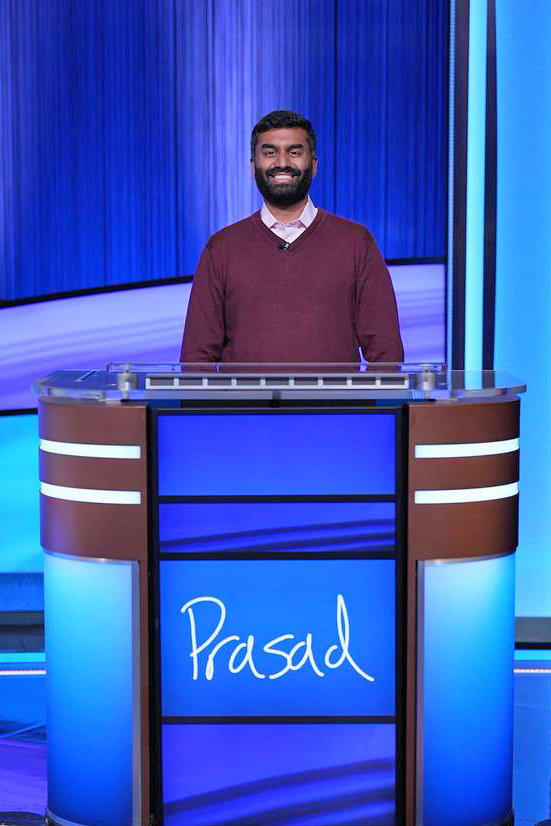SPH Professor Competes on Two Episodes of Jeopardy!

Prasad Patil, assistant professor of biostatistics at SPH, on the September 26 episode of Jeopardy!.
SPH Professor Competes on Two Episodes of Jeopardy!
Prasad Patil appeared on the September 26 and September 29 episodes of the game show, earning more than $35,000 in winnings.
Known as the “Father of Microbiology,” Louis Pasteur paved the way for modern medicine and public health, with groundbreaking discoveries of the pasteurization process, the rabies vaccine, and the principles behind disease spread.
And as the answer to the final clue on a recent episode of Jeopardy!, Pasteur—albeit indirectly and posthumously—helped pave the way for one School of Public Health professor to become a Jeopardy! champion.
Prasad Patil, assistant professor of biostatistics, fulfilled a years-long goal when he was selected to be a contestant on the nightly game show that has aired since 1964 and is currently hosted by Ken Jennings.
Appearing in the Friday, September 26 episode, Patil leapt to first place in the final moments of the game after correctly naming Pasteur as the answer to the Final Jeopardy! clue “Joseph Lister said there was not an individual to whom medical science owes more than to than this man, feted at the Sorbonne in 1892.”
“My mom is a big fan of the show, so I grew up watching it,” Patil says. “I’ve always been good at retaining information, so I thought I would try out for the show.”
He raked in $35,600 in winnings and the chance to compete in a second game. Unfortunately, his Jeopardy! run ended when he fell to second place during the Monday, September 29 episode, after leading significantly for most of the game.
Earning a spot on the show is a feat in itself. The selection process involves multiple rounds of qualifications, including individual and proctored tests on the Jeopardy! website, followed by a Zoom audition, before advancing to a pool of potential contestants who the show can call on anytime within a two-year window to compete on set. After completing this process three times over the last seven years, Patil was officially selected last spring to participate in a live studio taping, which took place in August in Los Angeles, where Jeopardy! is based.
He says participating in the show was an unforgettable experience that felt surreal when he watched the episodes air on television.
“It was very cool to be on the show, but also weird to watch myself on TV,” says Patil. With limited editing and short breaks only for commercials, the format is as fast-paced during the taping as it is for the viewers at home, but he says he managed to perform well under pressure. “When I watched the episodes on TV, there were actually a couple of answers that I didn’t know—but on the show, I buzzed in and got them correct. Somehow I knew them at the time.”
Since joining SPH in 2019, Patil has studied machine learning applications and statistical methods focused on improving the generalizability of predictive models, with research interests in tuberculosis, air pollution exposure through airplane activity, and opioid overdoses among incarcerated populations. He’s well versed in health, science, and math, as well as movies, TV shows, pop culture, and sports, but when he found out he was going to be a contestant, he brushed up on other topics, including art history and geography.
By sheer coincidence, all three participants on the September 26 episode worked in the medical or health science fields, making the Final Jeopardy! clue about Pasteur even more fitting (the final clue in the September 29 episode focused on medieval names).
Patil says the most important preparation for the show was not about broadening knowledge base, but about improving his reaction time with the buzzer and learning how to develop betting strategies for the game’s Daily Double and Final Jeopardy! segments.
“Everyone who plays on Jeopardy! is brilliant, so the key to winning the game is learning how to buzz in fast enough when you have an answer, which you can practice with online tools and digital USB buzzers that mimic the actual device.”
Another highlight of this experience, he says, is the congratulatory emails, texts, and calls he’s received from friends and colleagues from different phases of his life, as well as people he’s never met.
“I even had a high school student email me and say they were interested in learning more about my research,” Patil says.
Final score: a win for Patil and for public health.